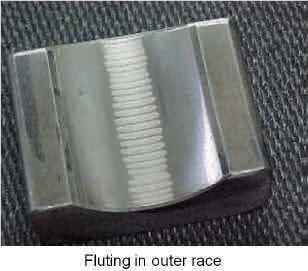BEARING LUBRICATION FAILURE
Posted on Monday Jun 04, 2018 at 04:25PM in Mechanical
Article by: Dan Whitehouse
Bearing failure due to lubrication is a very common occurrence. About 50% of bearing failure is related to lubrication. Below is a section of an article from www.machinerylubrication.com that details eight failure mechanisms. (Full article can be read here.)
When in doubt, it does not hurt to ask when lubrication comes into play.
1. Unsuitable Lubricant - First, you must choose the correct lubrication for the application. Fundamental properties, such as the viscosity, additive package and consistency (for grease), should be carefully selected based on the bearing type, speed factor and operating conditions. If these factors are not thoroughly considered and an unsuitable lubricant is applied, the lubricant may become overly stressed or be insufficient for the machine's lubrication needs. In either situation, the bearing will likely undergo premature wear and failure.
2. Lack of Lubricant - For greased bearing applications, the correct regreasing volume and frequency must be established to ensure the bearing load zones are lubricated properly. Too much time between regreasing intervals or applying too little grease will cause excessive boundary and bearing wear.
HYDRAULIC FILTRATION
Posted on Monday Jun 04, 2018 at 04:22PM in Fluid Power
By: Steve McKown
The life blood of the hydraulic system is the fluid, and it is usually the last thing customers think about. Contamination in the fluid causes wear and damage to the moving components inside a system and can cause it to fail prematurely. Here are some key points on filtration.
New hydraulic fluid: New fluid should be filtered before it is used. Contamination gets into the fluid during the processing and packaging phases. Filter carts are available to clean this fluid before use.
Cleaning the tank: If the filters in the system clog they will bypass and return unfiltered fluid to the tank. Particles settle out of the fluid over time leaving a layer of gunk at the bottom of the tank. Most tanks have a panel that can be removed to clean this out. Keeping the tank clean will increase the life of the filters.
Suction filters in the tank: In the past most tanks were equipped with a screen suction filter on the suction tube. The tank manufacturers are going away from this because if the screen clogs it can pull a vacuum on the pump causing a catastrophic failure. They now rely on the high and low-pressure filters to catch debris in the system. This makes the high-pressure filtration even more important.
Desiccant Filler Breathers: Moisture acts like an abrasive in the hydraulic systems and can cause severe damage. Using a desiccant breather cap removes the water vapor from the air.
Return Filter: this is the filter you will see most often on the power units. This cleans the fluid as it returns from the system and removes the particulates introduced into the fluid by the seals, hoses, and moving parts in the system before returning to the tank. If you have a worn rod seal on a cylinder it will pull dirt into the cylinder contaminating the fluid. If you have older hoses they deteriorate and dirty the fluid.
GATES MECTROL: PC-10 AND PC-20
Posted on Friday May 11, 2018 at 07:41AM in Belting & Conveyors
By: Ken Harville
Looking for a better posi-drive belt option? Do you have complaints about excessive stretching, wavy belt edges, and sprocket disengagement? Do you need to replace plastic modular with fabric belting? Well then here is the answer, Gates Mectrol's Posiclean PC-10 and PC-20 Kevlar reinforced, posi-drive belting.
PC-10 and PC-20 are 1” and 2” pitch respectively, and their Kevlar reinforcement eliminates belt stretch, wavy belt edges and sprocket disengagement. Further, these 2 belts allow customers the ability to drive these belts without the aid of UHMW “shoes”. Shoes increase belt wrap at the drive sprockets, but they also cause wear and tear on the belt’s surface and edges.
BEARING CURRENTS
Posted on Friday May 11, 2018 at 07:29AM in Mechanical
By: Blake Timmons
With the increased use of Variable Frequency Drives (VFDs) in industrial and commercial electric motors, there becomes a source of current flow through the bearing. Note that inverter-induced bearing currents and premature bearing failures occur in a relatively small percentage of installations and applications. Nevertheless, it's best to understand the topic when you run across the problem.
The damage to the outer or inner race of a motor bearing will look something like the pictures below.


The damage to the outer or inner race of a motor bearing will look something like the pictures below. In these photos. Notice that the “fluting” is seen as symmetrical damage which is a common sign of a bearing current issue. Also notice that damage can also occur that is not symmetrical, shown by individual random spots on metal surfaces. With motors using with an inverter, you need to be aware of the high-frequency current paths from the motor back to the inverter and to ground. This will help in understanding potential bearing current problems and remedies. High frequency motor bearing currents can occur in any motor driven by a drive using Pulse Width Modulation (PWM).

